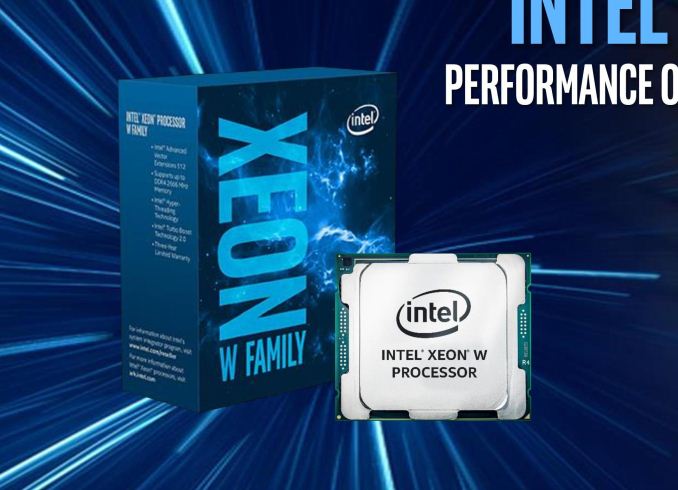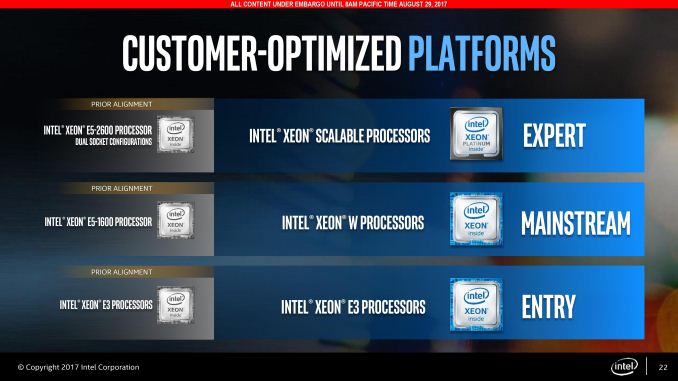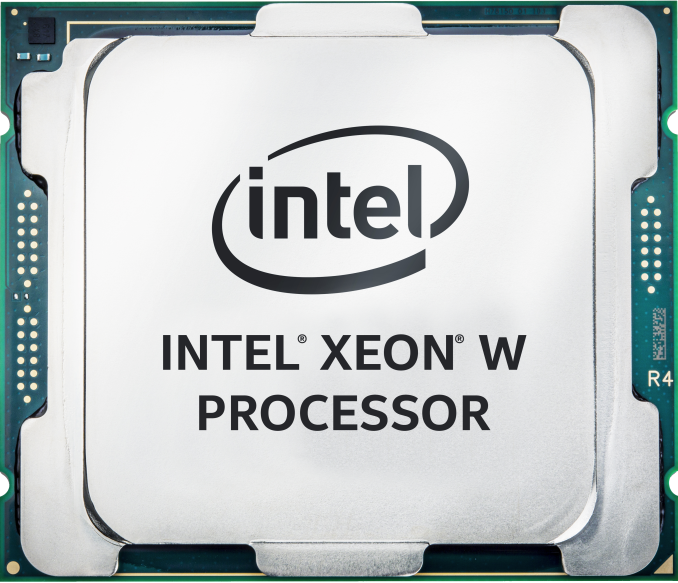Intel Launches Xeon-W CPUs for Workstations: Skylake-SP & ECC for LGA2066
by Ian Cutress on August 29, 2017 11:00 AM EST- Posted in
- CPUs
- Intel
- Enterprise
- Workstations
- ECC
- Skylake-SP
- LGA2066
- Xeon-W
- AVX-512
- C422

On the professional side of the CPU space, Intel’s new Xeon Scalable Processor family, based on the Skylake-SP architecture, is suiting up against the new EPYC processors from AMD. Part of Intel’s Xeon-SP launch was a rebranding of their product stack: gone are E5 and E7 families, and now Platinum, Gold, Silver and Bronze make for a confusing conversion. With this announcement, Intel also gave the image that now consumer and professional platforms were separate: no longer were Xeons welcome in consumer sockets. However as it turns out, this would not quite be the case.
Today Intel is taking the wraps off of their new Xeon-W family of processors, which will be their new brand for workstation-class processors. With the Xeon-W announcement today, Intel is bridging the gap between servers and consumer processors (in name at least) with a direct replacement for the old E5-1600 series, which will see Skylake-SP Xeons come to the LGA2066 socket with additional professional-level features in tow.
Historically, the E5-1600 series were identical processors to the E5-2600 series, except without the dual socket capabilities and consequently priced more appropriately for single socket workstations. Meanwhile over the last few generations, the consumer and enterprise platforms shared a socket, which made cross compatibility fairly easy.
With the new Xeon-SP processors, however, the enterprise platform went up to Socket LGA3647. This new socket is a far cry from the consumer LGA2066, losing a common platform in exchange for more memory channels and other features such as Omnipath. With a complete division between consumer and enterprise, there was no way to bring features such as ECC and vPro down into more consumer friendly environments.
Today’s launch of Xeon-W fixes this, although you probably still need a new chipset. As a replacement for the E5-1600 series, the Xeon-W CPUs will feature parts from 4 cores up to 18 cores, support up to 512GB of ECC RDIMM/LRDIMM memory, support dual 512-bit FMAs throughout the stack, and peak turbo clocks of 4.5 GHz.
| New Intel Xeon-W Processors (LGA2066) | |||||||
| Cores | Base Freq. |
Turbo 2.0 |
L3 (MB) |
L3/core (MB) |
TDP | Price | |
| Xeon W-2195 | 18/36 | 2.3 GHz | 4.3 GHz | 24.75 | 1.375 | 140 W | TBD |
| Xeon W-2175 | 14/28 | TBD | TBD | 19.25 | 1.375 | 140 W | TBD |
| Xeon W-2155 | 10/20 | 3.3 GHz | 4.5 GHz | 13.75 | 1.375 | 140 W | $1440 |
| Xeon W-2145 | 8/16 | 3.7 GHz | 4.5 GHz | 11.00 | 1.375 | 140 W | $1113 |
| Xeon W-2135 | 6/12 | 3.7 GHz | 4.5 GHz | 8.25 | 1.375 | 140 W | $835 |
| Xeon W-2133 | 6/12 | 3.6 GHz | 3.9 GHz | 8.25 | 1.375 | 140 W | $617 |
| Xeon W-2125 | 4/8 | 4.0 GHz | 4.5 GHz | 8.25 | 2.063 | 120 W | $444 |
| Xeon W-2123 | 4/8 | 3.6 GHz | 3.9 GHz | 8.25 | 2.063 | 120 W | $294 |
In essence, these are Xeon versions of the current Skylake-X (Core i9) processors with all the pro features enabled, such as the extended memory support, vPro, Intel’s AMT, and the standard enterprise Reliability, Serviceability and Availability (RAS) features. They will require a new chipset, the C422 chipset, and despite the common LGA2066 socket, the Xeon-W will not work with the consumer X299 chipset (reaffirming the split we see with the E3-1200 v5/v6 series which require the C236 chipset and will not work with the Z170 chipset). As a result, we are likely to see most of the major motherboard manufacturers pump out at least one version of an enterprise board to cover this market.
Starting at the bottom of the new Xeon-W product stack, we find something interesting: Intel is releasing a pair of four core parts that have 8.25MB of L3 cache, rather than the 5.5MB we would expect from a 1.375MB/core Skylake-SP design. This indicates that these parts retain access to some of the L3 cache attached to the disabled cores, making them particularly well suited for software that is licensed per CPU core and consequently needs the the highest single-threaded performnace possible. There are two 6 core members of the stack, which differ solely on clock speed. This is then followed by an 8 core, a 10-core, a 14-core and an 18-core, with no 12-core or 16-core present (although if launched, these are likely to be called the W-2185 and W-2165). All the parts will support 48 PCIe 3.0 lanes from the processor, suitable for 2x GPU and 3x PCIe storage direct from the CPU without going out to the chipset (in the consumer Skylake-X product line, the two bottom SKUs only have 28 PCIe lanes, and the rest have 44). Every processor in the Xeon-W stack sits at 140W, except the quad cores at 120W. By contrast, Skylake-X goes up to 165W. It is also worth noting that the Xeon-W processors only support Turbo Boost 2.0 rather than Turbo Boost Max 3.0 and its "favored core" underpinnings. And as with past Xeon processors, Xeon-W processors are also likely to be locked.
| Top SKU Comparison | |||
| Features | Skylake-X (i9-7980XE) |
Xeon-W (Xeon W-2195) |
Skylake-SP (Xeon 8180/M) |
| Platform | X299 | C422 | C620 |
| Socket | LGA2066 | LGA2066 | LGA3647 |
| Cores/Threads | 18 / 36 | 18 / 36 | 28 / 56 |
| Top Base/Turbo | 2.6 / 4.2 | 2.3 / 4.3 | 2.5 / 3.8 |
| GPU PCIe 3.0 | 44 | 48 | 48 |
| DRAM / DDR4 | 128GB UDIMM Quad-Channel |
512GB RDIMM+LRDIMM Quad Channel |
768GB/1536GB RDIMM+LRDIMM Six Channel |
| TDP | 165W | 140W | 205W |
| Price | $1999 | TBD | $10009 / $13011 |
There are several obvious comparisons that can be made between the Xeon-W family and both the consumer Skylake-X and the server Xeon-SP platforms. Intel’s goal here is to hit something in the middle: an increase in price over Skylake-X gets you more memory support, ECC, more PCIe lanes, and management features, but doesn’t go the full way to six-channels of DDR4 or multi-socket support. Not all of the Xeon-W parts have specifications and prices yet, but the 8-core processor is a good place to do comparisons.
| 8-Core Comparison | |||
| Features | Skylake-X Core i7-7820X |
Xeon-W Xeon W-1245 |
Skylake-SP Gold 6144 |
| Platform | X299 | C422 | C620 |
| Socket | LGA2066 | LGA2066 | LGA3647 |
| Cores/Threads | 8 / 16 | 8 / 16 | 8 / 16 |
| Base/Turbo | 3.6 / 4.3 | 3.7 / 4.5 | 3.5 / 4.2 |
| GPU PCIe 3.0 | 28 | 48 | 48 |
| DRAM / DDR4 | 128GB UDIMM Quad-Channel |
512GB RDIMM+LRDIMM Quad-Channel |
768GB RDIMM+LRDIMM Six Channel |
| TDP | 140W | 140W | 150W |
| Sockets | 1 | 1 | Up to 4 |
| Price | $599 | $1113 | $2925 |
The consumer Core i7 has fewer PCIe lanes and the most limited DRAM support, but it's the cheapest. Conversely, the Xeon Gold CPU is easily the most expensive, but it supports up to four sockets, has more L3 cache per core overall, and gets the greatest memory capacity, while incurring a slightly higher TDP in the process. The Xeon-W then sits neatly in the middle, taking advantage of high clock frequencies and pro features with a small bump in price, without forking over for multi-socket support.
Of course, we can put the Xeon W-2145 up against AMD’s Threadripper 1900X and EPYC 7401P too:
| Comparison | |||
| Features | Xeon-W Xeon W-1245 |
AMD Ryzen TR 1900X |
AMD EPYC 7401P |
| Platform | C422 | X399 | - |
| Socket | LGA2066 | TR4 | SP3r2 |
| Cores/Threads | 8 / 16 | 8 / 16 | 24 / 48 |
| Base/Turbo | 3.7 / 4.5 | 3.8 / 4.0 | 2.0 / 3.0 |
| GPU PCIe 3.0 | 48 | 60 | 124 |
| DRAM / DDR4 | 512GB LDIMM+RDIMM Four Channel |
128GB UDIMM Four Channel |
2 TB RDIMM + LRDIMM Eight Channel |
| L3 Cache | 11.00 MB | 32 MB | 64 MB |
| TDP | 140W | 180W | 155W/170W |
| Price | $1113 | $549 | $1075 |
For both parts that have the same core counts, Intel has the frequency advantage (and the performance advantage) and the power advantage, but AMD's chips have 60 PCIe lanes, more memory support, and are cheaper. When the 1950X doubles the cores but reduces the frequency, it still comes out cheaper than the Xeon W. Intel still has dual 512-bit FMAs/AVX-512 support, which Intel says is a big bonus in this market, and will point to its single thread performance.
While today is the formal announcement of the Xeon-W family, Intel has not announced much in the way of release details other than that the 14/18 core parts will be available in Q4. The rest are likely to come to market sooner, and we have requested details on retail availability. We’ve also had a lot of requests for workstation level testing or Xeon vs EPYC, and we’re in touch with both companies to get our hands on processors as soon as we can.
To clarify, we're still waiting on information about CPU/chipset support, and if Xeon-W will be supported in X299 motherboards. We will update this piece when we get that information.
Update 1
We fired a few questions to Intel, and got a few answers.
- Chipset Support: Xeon-W will only work in C422 motherboards. C422 motherboards will not accept Core-X processors.
- DRAM: 128GB LRDIMMs are not supported. Intel feels this level of value does not benefit workstation users and directs them to the M versions of the Xeon-SP lines.
- Turbo Boost 3.0: Intel is not supporting this on Xeon-W, but has engineered TB2 to match the same frequency.
- Mesh Frequency: Intel refuses to disclose this publicly, even though anyone with a CPU could poll it to get the result. This was an odd response to this request.
Also on retail availability: Up to 10-core parts are available from OEMs from August 29th (today). However, only W-2123 and W-2135 are going to be on the shelf in official retail packaging. End users will have to procure the other parts through non-retail packs.




















50 Comments
View All Comments
Icehawk - Thursday, August 31, 2017 - link
What kind of job and work environment do you exist in? This is complete BS, our largest IT expense is software licensing and support and is for everyone else unless it is a year with a build out. Just like with AMD processors the vast majority of businesses are not using this "enterprise" grade freeware you are talking about. How many hyper V installs vs VSphere do you think there are, just for an easy one?This is like suggesting that companies would choose RC Cola and not Coke. Been out to eat recently?
linuxgeex - Tuesday, August 29, 2017 - link
Depends on your workload. If you need low latency then the faster clock and IPC of the W-2145 will be a big win for you. If you have a balanced workload that scales well and throughput is your only enemy then the 7351 will be better bang for the buck.Given how many workloads still don't scale well to dozens of threads I'd probably buy the Xeon unless I was absolutely certain I could assign it to run a single app that works well with Epyc for 4-5 years straight.
twtech - Tuesday, August 29, 2017 - link
Frequency does matter obviously, but what's most important is total work done.Let's say we had a workload that scales perfectly with the number of cores in the system - ie. 2 cores will do 100% more work than 1 core. In that case then, 2 cores at 2.3 GHz would be able to do more work than 1 core at 4 GHz, since 2.3 * 2 = 4.6, and 4.6 > 4.0. (In practice, most workloads don't scale perfectly, but some are pretty close.)
Now another factor that can complicate the mix is licensing terms. Most workstation applications will license per system. Enterprise server applications however may license on a per-socket, or per-core basis. Obviously that can complicate the equation, as if the software is licensed per socket, there may be a cost advantage to getting fewer CPUs with the highest core count possible. If the licensing is per-core on the other hand, then it might be most cost effective to try to maximize the performance you're getting per-core and minimize the number of cores you have to license.
twotwotwo - Wednesday, August 30, 2017 - link
People will have their reasons to buy the Intel--Apple's using it and some folks have unlimited budget and would like the single-threaded perf. But, yeah, if you're looking in this segment, you have at least one task that threads well, and it's going to be awfully tempting for some folks to either up their cores or save the money with a big old AMD chip.peevee - Tuesday, August 29, 2017 - link
Without REAL architectural or process improvements over the last 6 years, Intel has to resort to market fragmentation. Waste of engineers' time.TEAMSWITCHER - Tuesday, August 29, 2017 - link
So... Are these the processors we should be buying instead of Skylake-X for productivity? Does ECC offer any tangible benefit .. worth TWICE THE PRICE? I get the need for Market Segmentation but ... for me ... this all feels a bit forced. Xeon-W and Skylake-X are (for the most part) competing products.Ian Cutress - Tuesday, August 29, 2017 - link
ECC can be a mission critical requirement in a professional environment. If the error rate is 1 per GB per year, and a simulation requires 365GB to run for a month - that's 30 individual bit errors if you don't have ECC that could throw your results way off.cekim - Tuesday, August 29, 2017 - link
Having just finished a 9-day simulation run on 18 cores (and run many long sims over the years), it's usually a lot less distributed/diffuse/regular than that. No errors 99.999% of the time, but either an undetected/uncorrected or a error or something that crashes such a sim can be very problematic when the lost run and the time to debug its failure are added up. Debugging software this complex is bad enough if you can trust the hardware to get it right basically 100% of the time. Add in random failures and hilarity ensues.stux - Thursday, August 31, 2017 - link
++ this.ddriver - Tuesday, August 29, 2017 - link
Evidently, according to intel enthusiasts ECC doesn't matter in the context of the technology being absent from a 2000 DOLLAR CPU. Nobody needs that, they say. So allegedly, that 2000$ CPU is just a toy, meant to play games and movies, rather than doing actual work on it.But then again, seeing the kind of price premium intel asks for ECC, it does seem kind of a big whoop.
I say if you work with lots of data, and that data is important to you, and it depends on orders of magnitude of more intermediate data, ECC is an ABSOLUTE MUST.
Which is why ThreadRipper is so exciting, not only does it enable a whole new level of performance at a whole new level of affordability, but it also enables a whole new level of reliability by having ECC support enabled without charging half a kidney for it.
In fact, there are even some Ryzen boards which support ECC, even thou AMD is not stepping with guaranteeing that support, it seems that some mobo vendors have put in the work. Also, Ryzen pro will likely see more dedication to ECC support.
Intel too has ECC on some cheaper products, but like... atoms and such, which are entirely pathetic in terms of performance, even at running NAS, the sole purpose for their existence.
It will take a lot more squeezing before greedy old intel finds the generosity to enable ECC support on more affordable product lines, chances are it is already there, they simply disable it on purpose to milk fools out of their money.